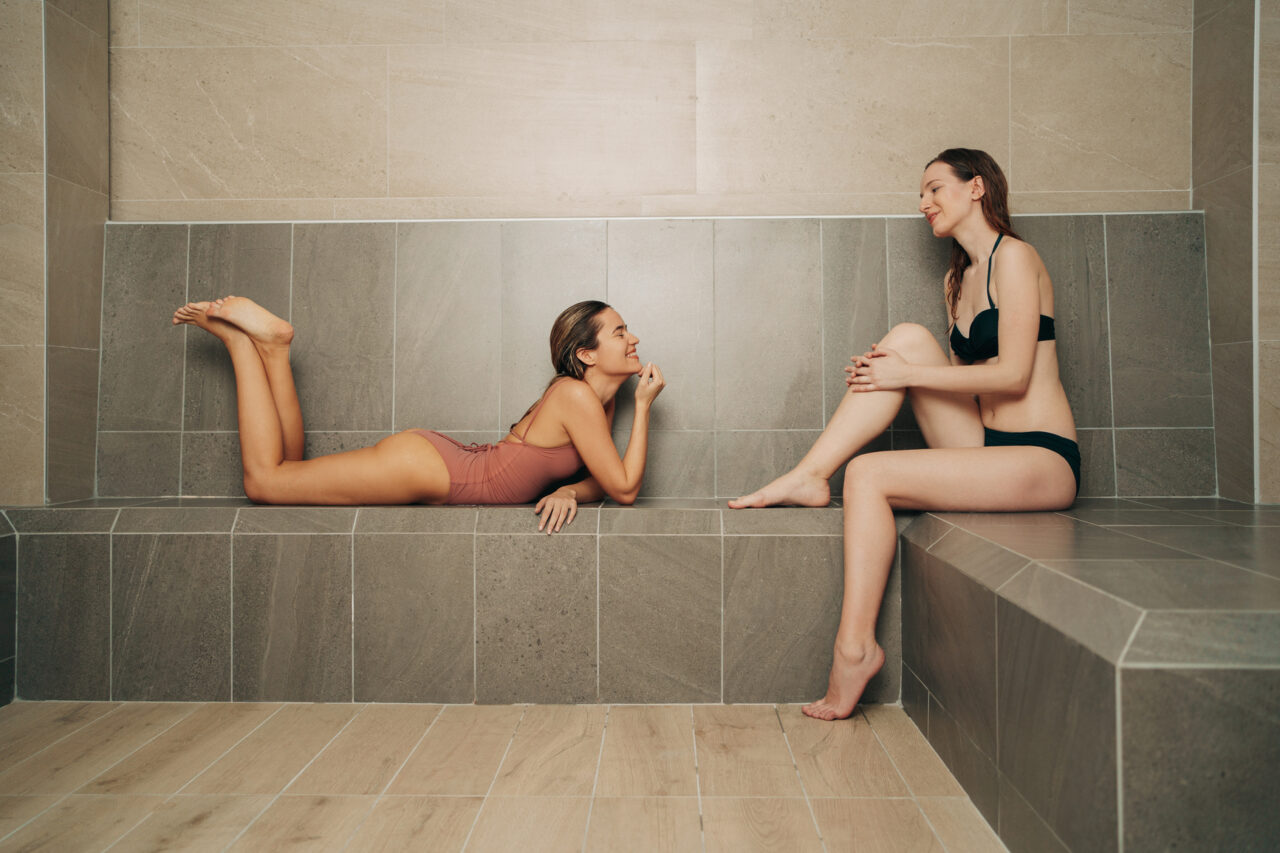
Taking a sauna after a workout – that’s how you profit from it
Sauna is a popular way to relax and regenerate – especially in the colder months of the year. But is it useful to go to the sauna after a workout? Can a session in the sauna help not only with rejuvenating your muscles, but also with improving your performance?
We spoke to Michael Küpper, Managing Director of Neptunbad Sports & SPA in Cologne, to learn more about the topic. Find out what benefits a sauna has for your body after a workout, how often you should take a sauna, and much more here.
How does a sauna effect you after a workout?
A sauna after athletic activity is an optimal complement to a workout. The increased temperature improves blood flow, relaxes the muscles, and promotes active recovery and relaxation of the body.
What is a sauna?
The term sauna comes from the Finnish language and translates to room of wood. In keeping with the translation, a sauna is exactly that: a room or a cabin that consists mostly of wood and that is heated to temperatures of up to 130 degrees Celsius with a sauna heater. While in Germany, saunas are usually used for active regeneration of the musculature and for the recuperation of body and spirit, things are done differently in other countries. In Scandinavian countries, for example, or in Russia, important things are even discussed in these rooms – also among politicians.
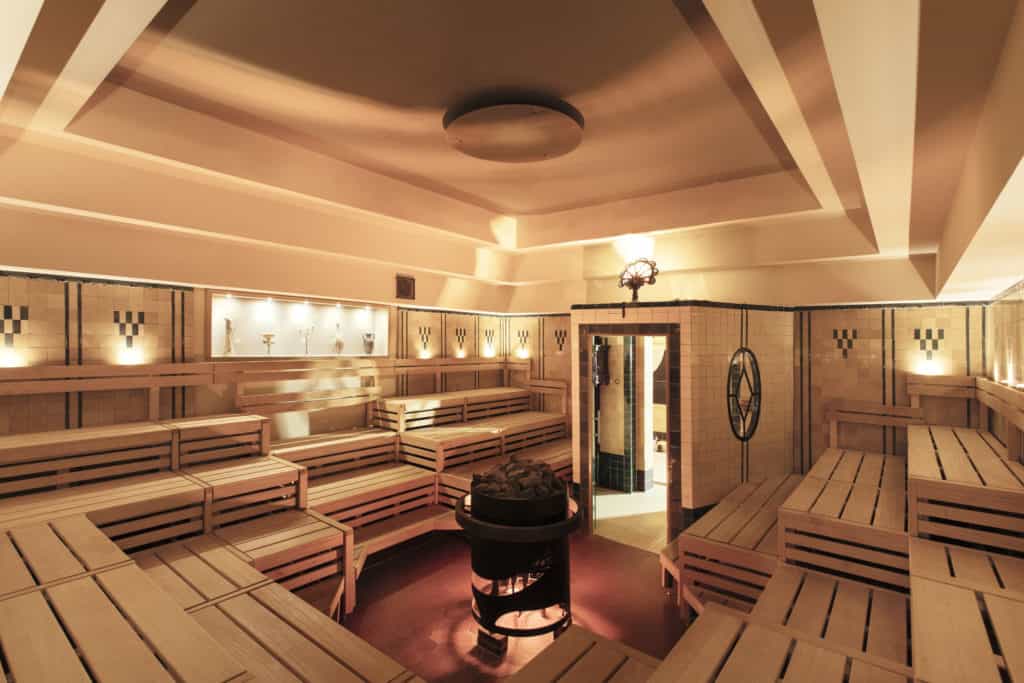
Taking a sauna before or after a workout
There are some health benefits to a sauna session, but a sauna is not recommended before a workout. “A sauna session should always be done after the workout, because the water loss impedes muscle activity, and the increased heart activity lowers the body’s performance,” says Michael from Neptunbad Sports & SPA. More specifically, when sweating, your heart’s activity increases and your pulse increases by more than half of your normal rate. This resembles the stress during a workout. Through sweating and loss of liquid, your performance ability also drops if you go into the sauna before your workout. A combination of a sauna before the workout would therefore be counterproductive.
In addition, your body and your mind are primed for relaxation after a sauna. Michael explains further: “Additionally, taking a sauna is also always a part of the cool-down and calm-down phase, which should be about as long as a sauna session. These phases are just as important for the feeling of relaxation as the sauna session itself. Having a sauna session after a workout enhances recovery, supports the metabolism, and helps to relieve or prevent muscle strain or muscle pain.”

A sauna after a workout?
A study from the University of Southern Australia confirms the benefits of visiting the sauna after a workout – both for top athletes and for everyday athletes. Researchers found that the athletic performance of the athletes was significantly increased by regular sauna sessions. The heat promotes blood flow to the muscles, which leads to increased protein synthesis in the muscles and in turn leads to stronger muscle growth and a better adaptation to the workout. There is already an effect after just five sauna visits after a workout. Probably 14 or more sessions are required for a complete adaptation.
Additionally, a study in New Zealand indicates that the physiological adaptations to sauna sessions could improve endurance. In the study, long-distance runners went to the sauna for three weeks after working out. The result was an approximate two percent improvement in performance during endurance running.
Is taking a sauna after a workout good for your health?
The answer is simple: Yes! The session in the sauna after a workout has health benefits aside from the relaxation and rest. But it is important that you take a break after your workout session and don’t go straight into the sauna. You can find some important information on this in the article below under “What should I do before going into the sauna?”.
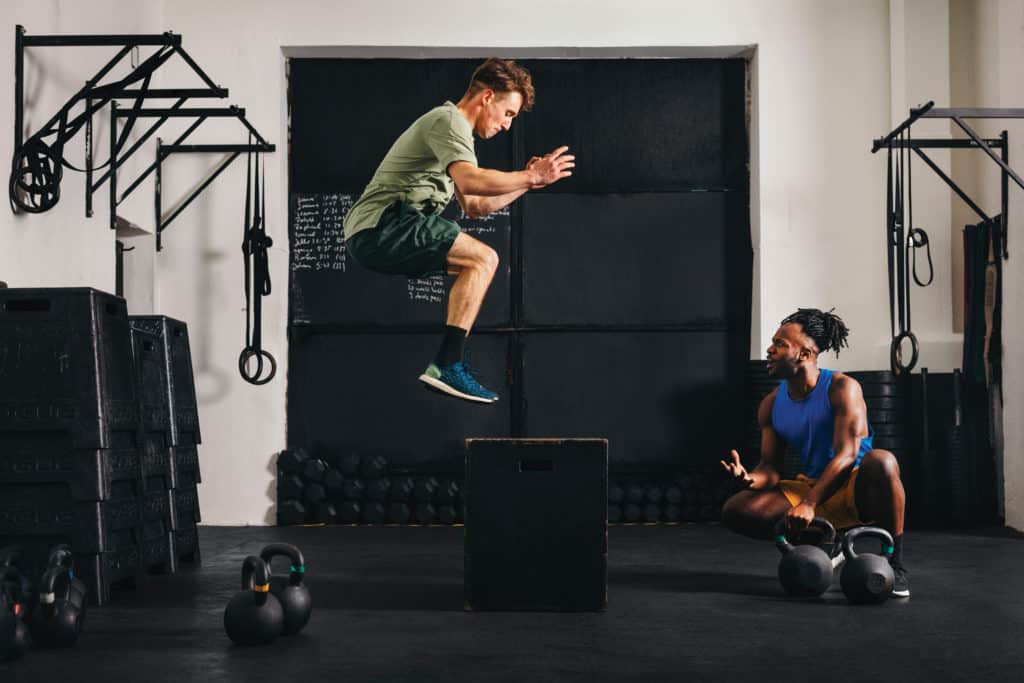
For now, let’s stick with the health benefits. According to a study from the University of Eastern Finland, regular sauna sessions can even increase your life expectancy. The risk of sudden death is considerably lowered through consistent cardiovascular workouts. A visit to a sauna once or twice a week can reduce this risk by about 20 percent. In addition, a sauna session can prevent sore muscles after a workout.
Here are some of the most important benefits of saunas:
- Improved blood flow: The high temperature in the sauna stimulates your blood flow. This can promote the recovery of smaller muscle injuries and general muscle recovery.
- Increased performance by up to two percent
- Improved overall complexion
- Strengthened immune system and defenses: The effects of a sauna help to strengthen your body’s defenses. This helps you to be less vulnerable to colds and other infections. The heat also helps you to sweat out various toxins that have built up in the tissue.
- Improved functioning of the lungs and respiratory system
- General lowering of blood pressure and improvement of the cardiovascular system
- Reduced stress
What should I consider before going into the sauna?
Before starting your first sauna session, there are a few things you should note. Most importantly, avoid going in the sauna right after a workout! After a workout, your body is under the influence of the stress hormone cortisol. Therefore, we recommend resting for about a half an hour so that your body doesn’t experience another strain immediately. The rest phase helps to normalize your pulse and reduce your cardiovascular load. You can also use the time to take a shower after the workout. This is important not only for hygienic reasons, it also helps to remove any oil that has accumulated on your skin. Important: Dry off well after your shower – dry skin sweats better.

And another important thing: Hydrate often! Ideally before and after your sauna session. The heat in the sauna will cause your body to sweat and lose fluids. A water deficiency can give you headaches and reduce your concentration. Therefore, it is important to compensate for a loss of water and minerals in the body, especially in the muscles. The best way to compensate is with mineral water. The amount of water you drink should be about one liter per sauna session.
In addition, you should avoid going into the sauna on an empty stomach – but also not immediately after eating or drinking alcohol. Since taking a sauna stimulates kidney activity, we also recommend going to the bathroom before your first sauna session. Last but not least, you should read over the rules before going to the sauna. In Germany, it is normal to take a sauna naked; in the US, swimming suits are usually required. Now, just pack your towel to sit on and let’s get started!
Here is a summary of the most important points:
- Read the sauna rules
- Hydrate regularly
- Pack a towel to sit on
- Shower before your first sauna session and dry yourself off well
- Treat your body to 30 minutes of rest after the workout
- Don’t go in the sauna on an empty stomach, but also not immediately after eating
- Do not take a sauna after drinking alcohol
- Go to the bathroom before the sauna
What do I need to be aware of during and between sauna sessions?

As soon as you enter the sauna, spread your sauna towel or regular towel over the area where you want to sit or lie. It is important that your sweat does not come in contact with the wood. If the space allows for it, we recommend that you lay on your back. Stay in the sauna only as long as you feel comfortable. It is important that you pay attention to what your body is telling you. If you have never been in a sauna before, here’s a tip for beginners: Think about temperature distribution! If you notice that a new infusion is a bit too hot for your conditioning, just sit on a bench that’s a bit lower.
Why should I take a cold shower or cool down significantly after the sauna?
You have probably heard that it is usual to cool down heavily after a sauna. If you shy away from this and think that your health will benefit from the sauna session just as much if you just take a lukewarm shower, we’re sorry to disappoint you. The desired health-promoting effect can only be achieved through a vigorous cooling phase or a serious cool-down. Michael from Neptunbad Sports & SPA explains. “The heat from a sauna session expands your blood vessels, and your heart beats faster. By using cold water when showering after the sauna session, your blood vessels narrow back down and your heart rate is briefly increased. The change of temperatures will enhance your recovery effect during the rest phase. When repeated regularly, this also has the effect of training your immune system.”

How can I cool down properly after the sauna?
It is important not only that you cool down after each sauna session, but also that you follow the correct order in cooling your extremities. This ensures that you don’t overburden your circulation. Michael explains that when you are in the cooling phase or the cool down, you should start further away from the heart. Start with the outer extremities: First the right leg, then the left, then the right arm and the left, and finally the upper body or torso. Then you should cool down your entire body with a cold shower or a dousing shower. To relax the blood vessels directly, you can then treat yourself to a warm foot bath.
Duration and number of sauna sessions
The duration and number of sauna sessions is based on the type of sauna and your personal tolerance. The hotter a sauna is, the more careful you should be. We advise you never to sweat for too long at high temperatures. Generally, you can follow the 15–15–30-minute rule. According to this rule, a complete sauna session consists of a sauna of a maximum of 15 minutes, cooling down for 15 minutes, and then 30 minutes of rest before beginning the next sauna session. Remember to cool down using cold water between the sauna sessions.
- One sauna visit a week:
We recommend two sauna sessions, and no more than three - Two sauna visits a week:
Here, two sauna sessions are entirely sufficient - With daily sauna visits:
A maximum of one sauna session
What is the ideal sauna type and sauna temperature?
There is no ideal sauna temperature or sauna type. The choice depends entirely on your personal preferences, your general state of health, and your experience. If you have only just started going to the sauna, we recommend starting with low temperatures. This will help your circulation, your heart, and your blood vessels to slowly get used to it. When people think of saunas, they usually think of the Finnish sauna. However, there is much wider selection. To give you a little insight and not overload you with all the types, we have summarized a few facts.
Saunas below 60 degrees Celsius
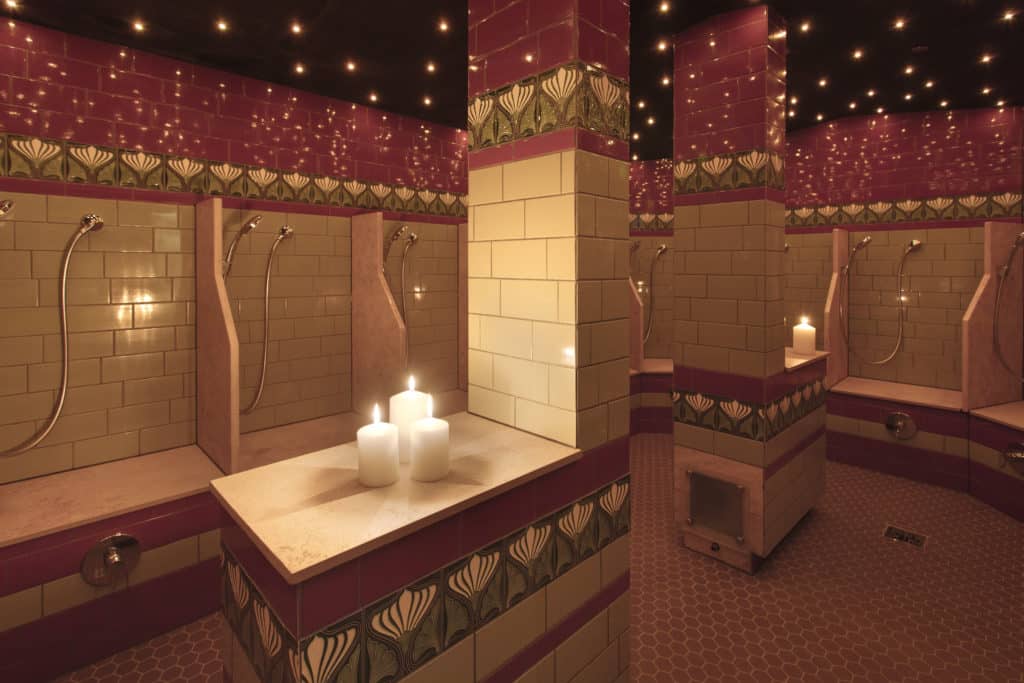
Saunas in this temperature range are particularly suitable for people who are sensitive to heat, people with high blood pressure, and children and people with weak circulation. There are a variety of sauna types in this category – some of them with a relatively high humidity. These sauna temperatures include classic steam baths such as the caldarium and the tepidarium (40 to 50 degrees Celsius), the baby sauna or the bio sauna (50 to 60 degrees Celsius), the infrared sauna (30 to 60 degrees Celsius), and the thermal room (40 to 60 degrees Celsius).
Saunas between 70 and 100 degrees Celsius

You are probably already familiar with the typical sauna type in this temperature range: the Finnish sauna. This sauna type is characterized by low humidity, which increases what we call the sauna effect and the health-promoting benefits. Through the interaction of heating and cooling, you will kick your cardiovascular system into gear and reduce your blood pressure. In saunas between 70 and 100 degrees Celsius, it is also common to use infusions with herbs and essential oils.
Saunas above 100 degrees Celsius
Saunas in this temperature range are characterized by extremely low humidity – below 10 percent. This sauna type is not recommended for beginners for the purpose of sweating. Also, if you are slightly more vulnerable due to your health, you should avoid these temperatures. The intense sauna effect is very noticeable here and is a particularly favourite of experienced sauna-goers. Included in these types are the earth sauna and the Finnish sauna, for example. However, the Finnish sauna is less frequently heated to such high temperatures.
Where can I find a sauna near me?
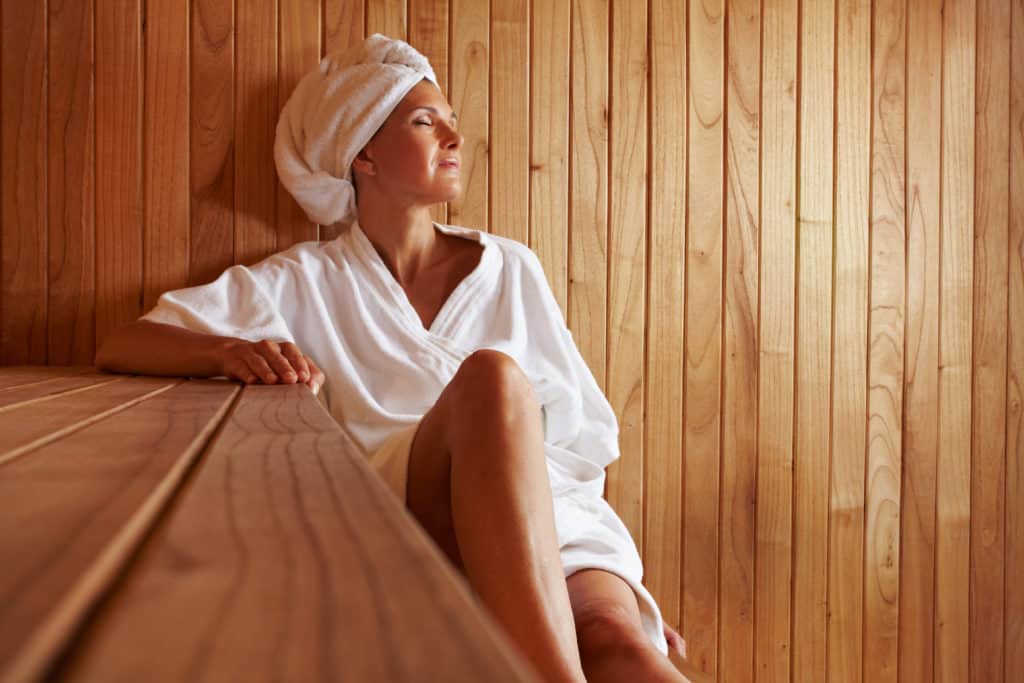
At Urban Sports Club, you have a wide range of sauna partners throughout Germany and Europe. There are some fitness studios with a sauna as well as several spas that make the perfect gift as a voucher for membership. Are you curious about the pictures of our interview partner Neptunbad Sports & SPA in Cologne? No problem! Visit them with your membership and treat yourself to the relaxation you crave. For example, work out at Holmes Place Bahrenfeld in Hamburg and then try out their sauna. If you are looking for more of a spa experience, we recommend Bäderland Bartholomäus-Therme. In Berlin, you can take a sauna at Holmes Place after your workout session or simply relax at Stadtbad & Hotel Oderberger. People in Munich can work out at body + soul and then take a sauna afterwards. For some good rest and recovery, we recommend the DoriVita. In Cologne, Holmes Place is a good alternative for a combined session. At Mauritius Therme, you can also do your body some good.
When shouldn’t I go to the sauna?
Despite countless health benefits of taking a sauna, sauna sessions at high temperatures are not recommended for everyone. We have compiled a list of conditions for why you should avoid the sauna, or at least consult your doctor beforehand. In general, it is recommended that you do not visit a sauna when you feel sick, due to the physical strain.
You must exercise caution if you suffer from these any of the following conditions:
- Severe asthma
- Pathological dilation of the blood vessels
- Advanced-stage cancer
- Rheumatism
- Kidney problems
- Circulatory disorders in the brain
- Glandular or heart disease
- Cardiac insufficiency, cardiovascular disease, heart problems
- Flu infections
- Fever
- Open wounds
- High blood pressure
- Inflammation
What is the sauna infusion all about?
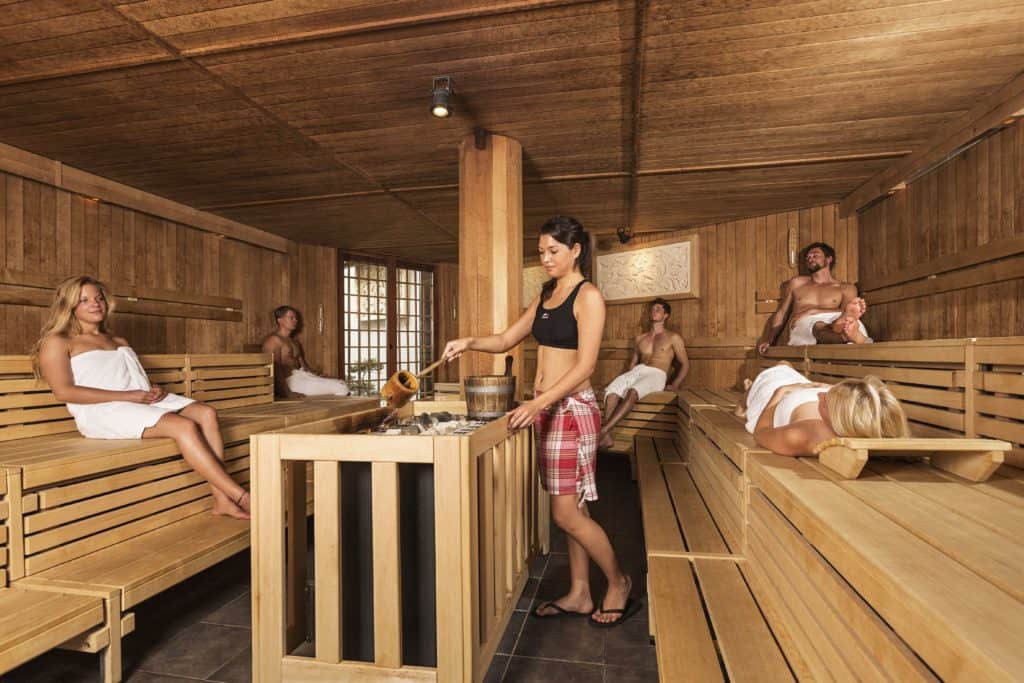
As already mentioned when talking about the different types of saunas, infusion is used in some sauna sessions. For many, this is the highlight of taking a sauna. Here, a wooden ladle is used to distribute infusion water over the heated stones. In this case, the strongest vapors also rise to the upper part of the sauna. Fanning the air with a cloth helps to distribute these vapors evenly. Essential oils also support the effect on the nervous system.
Sauna during pregnancy
Important to know in advance: We always recommend consulting your obstetrician or gynecologist when it comes to decisions that could affect the health of your child. Michael also confirms this: “Before you visit a sauna during pregnancy, you should visit a doctor, a midwife, or a childbirth professional to discuss any medical impediments.” If there are no complications, there is nothing to say you cannot visit a sauna visit during the second trimester. The relaxation as a result of a sauna visit, as well as the heat, is highly recommended during pregnancy, particularly for the back muscles. But pay attention to how your body feels and always move through the less intense areas of the sauna.”

For regular sauna goers
Taking a sauna has no effect on fertility and is safe during uncomplicated pregnancies in healthy women. Generally, if you are an experienced sauna-goer, you can visit the sauna as usual up until shortly before birth if you are going through a healthy pregnancy. This will even promote your health during pregnancy.
If you have no or hardly any experience with going to a sauna
If you are still a sauna beginner, you should approach the matter with great care during your pregnancy. In this case, it is all the more important to talk to your gynecologist in advance. Under no circumstances should you start during the first three months of pregnancy, because the baby reacts very strongly to fluctuations during this period.
In general, during pregnancy
Do not visit the sauna too frequently during pregnancy. Ideally, you should do a maximum of two sauna sessions per visit and go no more often than once per week. In this case, a sauna session should last between five and ten minutes. Michael provides further advice: “During pregnancy, you should use the lower levels of the sauna instead or a sauna at a slightly lower temperature so that you do not overly strain your metabolism, which changes due to pregnancy. This especially applies during the final weeks of pregnancy. Really high temperatures could induce labor.” For example, a bio sauna or a vivarium have lower temperatures than a Finnish sauna. We also recommend a warm foot bath before the sauna to stimulate your blood flow and to prepare your circulation. In addition, you should shower off with a hose instead of going in the plunge pool.
Sauna bathing while on your period
From a medical standpoint in general, there is nothing that advises against a sauna visit during menstruation; it even has some really great benefits and a good effect on your health. Michael also confirms: “Of course, the way a woman feels during her period varies greatly. As long as you feel comfortable with it, there is nothing standing in the way of going in the sauna while on your period.” If you are now wondering what the best hygiene product is, we also have a tip for you on this: Choose a product that is very absorbent. A menstrual cup or a soft tampon are especially recommended for the sauna. Moreover, you cannot see into a sauna from the outside if that makes you uncomfortable.

Using heat against abdominal pain
Cramps during your period are due to tense muscles. The heat in a sauna can be a big help in relaxing these muscles and relieving your pain. Michael also confirms this: “Taking a sauna has a truly relaxing effect in any case due to the heat, which relieves cramps and makes you feel better.” The effect of the sauna is therefore good for your health, even during your period.



Comments